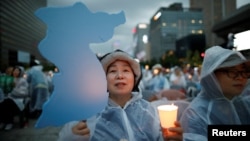More than half of South Korea’s university-age students now possess a positive view toward Korean unification. That’s according to a new poll conducted by the National Assembly’s Foreign Affairs and Unification Committee. The survey was conducted in early November, canvassing more than 1,000 university students nationwide.
The survey results show 52.8 percent of the respondents answered that “unification is necessary,” more than twice the number of those stating the opposite (26.1 percent).
One possible explanation for the survey’s results, said research fellow Park Ju-hwa at the Korea Institute for National Unification (KINU), could be North Korea’s friendlier approach to Seoul and outreach to the global community.
Furthermore, “until the [recent] summit(s), people didn’t have a chance to see the North Korean leader,” said Jeon Young-sun, professor at the Humanities Research Institute, at Konkuk University.
Park also said the absence of nuclear or missile tests the past year, coupled with high-profile meetings between South Korean President Moon Jae-in and North Korean leader Kim Jong Un “might bring about change in the minds of young people.”
Youth and Future director Jeong Hyun Gon added that the global focus placed on talks with Pyongyang helped to entice university students to become interested, where previously they hadn’t paid the issue a significant amount of attention.
The survey’s data further showed 42.1 percent of respondents moved from a negative perception to a positive view about North Korea following the Pyongyang Summit.
It’s a value more than eight times higher than those moving the opposite way on the spectrum (5 percent) and respondents stated the reason to pursue unification was “economic growth” (33.3 percent) and to “remove the threat of the war” (28.7 percent).
Youths’ needs drive positive outlook
South Korean President Moon has held three summits with his Kim, counterpart in North Korea. The latest, held in September in Pyongyang, finalized a series of military agreements aimed at de-escalating tension on the peninsula and creating new business opportunities through a number of inter-Korean initiatives, such as connecting road and railways and re-opening joint tourism and industrial complexes.
The students appeared to accept Moon’s assertion that stronger inter-Korean relations would benefit South Korea’s stagnant economy and eliminate the North’s military threat.
The authors of the report said the data showed the university students focused on aspects of improved relations with Pyongyang with nearly 7 in 10 saying greater cooperation with North Korea is urgently needed (67.2 percent).
Jeong noted “the young generation learned that unification is advantageous to them, so they took this practical approach.”
However, unlike the Moon administration, which has called for an easing of sanctions against North Korea to enable the inter-Korean initiatives, over half of the respondents called sanctions useful (55.4 percent) rather than unnecessary.
Those surveyed also said it was important to address North Korean human rights abuses, something the Moon administration has yet to pursue.
Moving forward
Park cautions reading too much into the survey’s conclusions because “a majority of past surveys only had a few options for respondents to select.”
He said while the data indicates the students are paying more attention to the economic advantage of unification, it’s unknown what their view will be if economic cooperation with North Korea does not occur.
“They are predicting an optimistic future,” said Jeong, although he notes students don’t necessarily expect to reap the rewards of unification in the near future.
“You can find from the survey data, they do not want to see the drastic unification with denuclearization first and then a step by step approach to unification, he added.
In the near future, South Koreans may “become frustrated with the process because of international opposition; however, looking long-term, the [positive] expectations hold,” Jeon said.
Park does note, however, there are some indirect benefits of North Korean engagement.
“[Engagement] can be an opportunity to develop North Korea and improve human rights in the North as well as in the South,” Park said.
In addition, he said the greater interaction with Kim and North Korea may contribute to peace in East Asia, and that it’s important “to consider the global value of unification.”
VOA’s Lee Ju-hyun contributed to this report.














